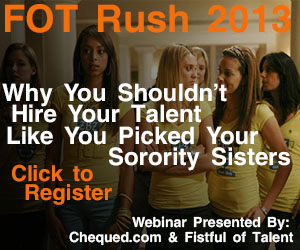WEBINAR: Why you shouldn't pick your talent like you did your sorority sisters
I think the biggest scam going in the HR/Recruiting/Talent game right now is this idea of 'Hiring for Cultural Fit'.
I've written about it a few times on the blog (most recently here), but the main point I keep coming back to is that 'Hiring for cultural fit' is simply code (and a convenient excuse) for 'Hiring more people that look/act/think/come from/share the same college just like us.'
I think it takes the focus off of what is usually more important criteria that needs to be considered in the hiring process, AND, it puts HR/Talent pros in a position where they are set up to fail. 
For the geeks out there - I'd say it is the Admiral Ackbar take on hiring - 'It's a trap!'
But fear not, O true believers, there is another way out of this trap. And my friends over at Fistful of Talent are ready and able to step in to help you learn how to focus on what really matters when making selection decisions in the hiring process.
Why is this important?
Because people have an innate and subconscious tendency to hire the most attractive, smooth-talking candidate when making a selection decision. But having the most attractive pledge class on the block may not always prove to be the best hiring strategy for driving your house’s bottom line.
That's why FOT'ers Tim Sackett and Kathy Rapp are going Greek this summer with the FOT webinar FOT’s 2013 Rush: Why You Shouldn’t Pick Your Talent Like You Did Your Sorority Sisters, brought to you by the team at Chequed.com.
Join Join your hosts Tim and Kathy on July 17 at 1pm EST and they’ll hit you with the following:
1. A deeper look at the old way of hiring paralleled to sorority rush. Skit Day and behavioral interviewing, matching interview polos and Lily Pulitzer-laden ladies, Pref Day and the final offer… sorority rush has bad HR written all over it. But adding more steps does not always lead to the best hire; that’s why FOT is giving you an actionable plan to align your hiring process with your desired candidate profile.
2. FOT’s complete guide to dumb things your hiring managers do when making hiring decisions — and how to change them. In order to break the mold you have to know what the problem is, right? We’ll cover items like hiring based on alma mater, handshake, favorite flavor of fro-yo, etc. in true FOT fashion. You guessed it — we’re calling out common biases and aligning them with your favorite Greek characters from pop-culture for easy reference when making your next hire.
3. We’ll explore the cliché “Hiring With Your Gut” and breakdown when that good old standard makes sense, when it’s lazy and when it may get someone fired (for a variety of reasons). While the paddle is optional in this section, not having a defined hiring process tied to an underlying job profile is not. Don’t worry, we’ve got you covered in this section.
4. Five rush strategies to end the Stepford Wife plague in your house today. Ready to mix up your pledge class? We’ll show you how to go from the House Bunny to a balanced group of team members in 5 simple steps.
5. We’ll wrap this webinar by bringing in an industry expert from Chequed.com for a little game of “It’s the freakin’ science, dude.” Hiring isn’t an art—it’s a science. We’ll give you the cliff’s notes on why so you can ace your next hiring exam.
Forget what you learned in college, and put FOT’s rush system to work at your company for a more balanced team today. Who knows, we may even get crazy with an FOT rendition of Shout to close this thing out right…
Register today:

 Steve
Steve

